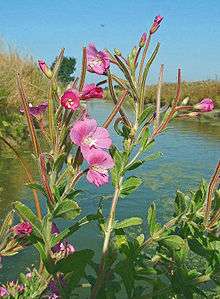Epilobium hirsutum
Epilobium hirsutum is a flowering plant belonging to the willowherb genus Epilobium in the family Onagraceae. It is commonly known as the great willowherb, great hairy willowherb or hairy willowherb.[2] Local names include codlins-and-cream, apple-pie and cherry-pie.

| Epilobium hirsutum | |
|---|---|
 | |
| Scientific classification | |
| Kingdom: | Plantae |
| Clade: | Tracheophytes |
| Clade: | Angiosperms |
| Clade: | Eudicots |
| Clade: | Rosids |
| Order: | Myrtales |
| Family: | Onagraceae |
| Genus: | Epilobium |
| Species: | E. hirsutum |
| Binomial name | |
| Epilobium hirsutum | |
| Synonyms[1] | |
|
List
| |
Description
It is a tall, perennial plant, reaching up to 2 metres in height. The robust stems are profusely hairy with soft spreading hairs.[3]:160[4] The hairy leaves are 2–12 cm long and 0.5–3.5 cm wide. They are long and thin and are widest below the middle. They have sharply toothed edges and no stalk. The large flowers have four notched petals. These are purple-pink and are usually 10–16 mm long.[5]:357 The stigma is white and has four lobes. The sepals are green.
Distribution
The native range of the species includes North Africa, most of Europe up to southern Sweden,[6] and parts of Asia. It is absent from much of Scandinavia and north-west Scotland. It has been introduced to North America[2] and Australia. It typically grows in wet or damp habitats without dense tree-cover up to 2,500 metres above sea-level. Common habitats include marshland, ditches and the banks of rivers and streams. It flowers from June to September, with a peak in July and August. The flowers are visited by many types of insects, and can be characterized by a generalized pollination syndrome.[7] A number of insects feed on the leaves including the elephant hawkmoth, Deilephila elpenor.
Ecology
Damp and waste places, river-sides and ditches.[8]
Trichomes
The plant shows glandular trichomes. They are unicellular, without a specialized basal cell. They have a cutinized cell wall and a protruding pore on the top. The upper part of the trichome cell contains flavonoids, e.g. quercitrin and myricitrin.[9]

References
- "The Plant List: A Working List of All Plant Species". Retrieved 20 November 2014.
- "Non-native Freshwater Plants: Hairy Willow-Herb". Washington State Department of Ecology. 2006. Archived from the original on 21 September 2016. Retrieved 6 September 2016.
- Blamey, M.; Fitter, R.; Fitter, A (2003). Wild flowers of Britain and Ireland: The Complete Guide to the British and Irish Flora. London: A & C Black. ISBN 978-1408179505.
- Martin, W. Keble 1965. The New Concise British Flora in Colour; with nomenclature edited and revised by Douglas H. Kent and foreword by The Duke of Edinburgh. London: Book Club Associates by arrangement with Ebury Press/ Michael Joseph (1982)
- Stace, C. A. (2010). New Flora of the British Isles (Third ed.). Cambridge, U.K.: Cambridge University Press. ISBN 9780521707725.
- "Rosendunört, Epilobium hirsutum" (in Swedish). Naturhistoriska riksmuseet. 1997. Retrieved 6 September 2016.
- Van Der Kooi, C. J.; Pen, I.; Staal, M.; Stavenga, D. G.; Elzenga, J. T. M. (2015). "Competition for pollinators and intra-communal spectral dissimilarity of flowers". Plant Biology. 18 (1): 56–62. doi:10.1111/plb.12328. PMID 25754608.
- Webb, D.A., Parnell, J. and Doogue, D. 1996. An Irish Flora. Dundalgan Press (W.Tempest) Ltd. Dundalk. ISBN 0-85221-131-7
- Krajšek; et al. (2011). "Morphology and glandular activity of unicellular trichomes of Epilobium hirsutum". Biologia Plantarum. 55 (1): 149–152. doi:10.1007/s10535-011-0020-z.
| Wikimedia Commons has media related to Epilobium hirsutum. |
- Blamey, Marjorie & Grey-Wilson, Christopher (2003) Cassell's Wild Flowers of Britain and Northern Europe, Cassell, London.
- Press, J. R.; Sutton, D. A. & Tebbs, B. M. (1981) Field Guide to the Wild Flowers of Britain, Readers Digest, London.
- Tutin, T. G. et al. (1968) Flora Europaea, Volume 2. Cambridge University Press. ISBN 0-521-06662-X